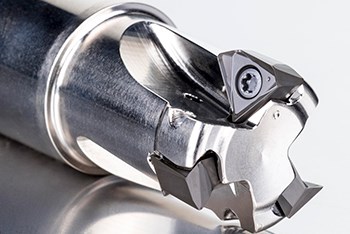Insert, Cutter Tool Range Ensure 90-Degree Shoulder Milling
Double-sided TNGX16 inserts and STN16 cutters from Dormer Pramet cover a large application and material range.

Photo Credit: Dormer Pramet
The new range of TNGX16 inserts and STN16 cutters for 90° shoulder milling in various materials from Dormer Pramet offer greater range of application. The larger double-sided inserts have six-cutting edges, for increased depths of cut (up to 0.394”) and higher feed compared to the existing TNGX10 range.
Low cutting resistance improves the connection between passes for high surface quality, as well as smoother, more quiet machining. Like most Dormer Pramet offerings, a positive geometry and through coolant enable improved chip evacuation across a wide range of materials, including steels, stainless steels, cast iron and non-ferrous metals.
The TNGX16 assortment is available in radii from 0.016-0.063” and a wide range of grades. It is supported by three geometries, F, M and FA. F is the first choice for low to medium carbon content steel. A high positive geometry with narrow peripheral land makes it suitable for light to medium machining. The M geometry is for machining carbon steel, stainless steel and cast iron. Its positive geometry with medium T-land, makes it ideal for light to medium machining. Suitable for non-ferrous metals, FA is a high positive geometry with a sharp cutting edge. Its polished insert face reduces sticking of machined material.
Further, the STN16 tool holders provide a higher number of teeth for greater productivity, compared to the original assortment. Its differential pitch offers smooth machining in diameters above 2”.
Manufactured from coated tool steel for better resistance against corrosion and reduce friction, the cutter features large and strong clamping screws for easier handling and stability. A precision-machined pocket design enables performance repeatability and security.
Related Content
-
Revisiting Some Hot Runner Fundamentals
What exactly does a hot runner do? If you’ve been in the injection molding industry for any length of time, you might think the answer is obvious, but it is not.
-
Maintaining a Wire EDM Machine
To achieve the ultimate capability and level of productivity from your wire EDM on a consistent, repeatable and reliable basis, regular maintenance is a required task.
-
6 Ways to Optimize High-Feed Milling
High-feed milling can significantly outweigh potential reliability challenges. Consider these six strategies in order to make high-feed milling successful for your business.









.png;maxWidth=300;quality=90)





